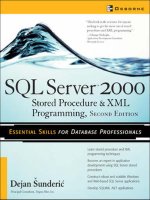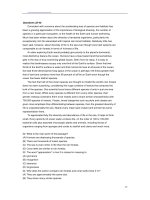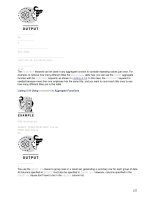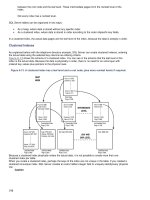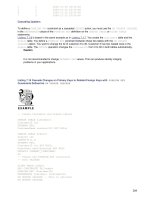SQL Server 2000 Stored Procedure Programming phần 2 pdf
Bạn đang xem bản rút gọn của tài liệu. Xem và tải ngay bản đầy đủ của tài liệu tại đây (658.91 KB, 76 trang )
60
SQL Server 2000 Stored Procedure Programming
4. Click Next and the wizard prompts you to select the database:
5. Click Next and the program presents you with a list of tables
in the database. The list contains three additional columns to
enable you to specify which stored procedures you want to
create. It is possible to create stored procedures for inserting,
deleting, and updating records.
Chapter 2: Relational Database Concepts and the SQL Server Environment
61
6. Mark a couple of boxes and click Next. The wizard creates
stored procedures for the specified operations. To record them
in the database, you need to click Finish. You can also change
their names or edit their contents.
7. Select a stored procedure and click Edit. The wizard displays
a list of the fields in the table. The Select column controls
which fields will be included in the stored procedure. In the
case of stored procedures for Update and Delete operations, it
62
SQL Server 2000 Stored Procedure Programming
is possible to specify which field will be used in a Where
clause as a key to filter records.
8. Click Edit SQL and the program displays the code for the
stored procedure. Here you can change generated code. It is
also possible to change the generated code after the stored
procedure has been recorded in the database.
Chapter 2: Relational Database Concepts and the SQL Server Environment
63
TIP:
One thing that I always do when I create a stored procedure in
this way is to remove the name of the database from the statement. In a
development environment, database names are often changed (for example,
when you set up a test database), and the name of the database should not
be hard-coded in the stored procedure. It should use objects from the current
database, not from the database in which the stored procedure was created.
9. Click OK twice to close open windows, and then click Finish
to record the stored procedures in the database.
The Create Stored Procedure Wizard is not perfect, but it will help
you to make your first stored procedures. Stored procedures created
in this way are very simple, but performance-wise and security-wise
it is much better to access data through such stored procedures than
to go directly to the underlying tables.
TIP:
I have to admit that I generate stored procedures using the wizard
from time to time. If the underlying table has many columns, it is much faster
to generate a stored procedure using the wizard than to type the stored
procedure from scratch.
SUMMARY
You have made your first steps in the development of stored
procedures in Transact-SQL. You have seen how to
▼
Connect to SQL Server from SQL Server Query Analyzer and
SQL Server Enterprise Manager
■
Execute stored procedures from Query Analyzer
■
Create stored procedures using SQL Server Enterprise
Manager, SQL Server Query Analyzer, and the Create Stored
Procedure Wizard
■
Edit stored procedures
■
Make and fix syntax errors
▲
Open SQL Server Books Online
EXERCISES
1. Open SQL Server Books Online and find documentation
about the sp_spaceused system stored procedure. Execute it
to find out the amount of space used by the Asset database.
2. Create a stored procedure prListEquipment to return a list
of equipment defined in the Equipment table of the Asset
database.
3. Change the stored procedure prListEquipment so that its
resultset includes equipment type in the form of text. See the
following diagram:
4. Execute the stored procedure prListEquipment.
64
SQL Server 2000 Stored Procedure Programming
CHAPTER
3
Stored Procedure
Design Concepts
65
Terms of Use
S
tored procedures are database objects that encapsulate
collections of Transact-SQL statements on the server for later
repetitive use. They are the equivalent of subroutines and
functions in other programming languages.
Upon completion of this chapter you will be able to
▼
Create a stored procedure
■
Explain the elements of a stored procedure
■
List ways to return information from a stored procedure
■
Pass input parameters to a stored procedure
■
Receive output parameters from a stored procedure
■
Receive a return value from a stored procedure
■
Explain where stored procedures are stored on SQL Server
▲
Explain the compilation and reuse of stored procedures
ANATOMY OF A STORED PROCEDURE
We can describe a stored procedure in terms of
▼
Composition
■
Functionality
▲
Syntax
Composition
Logically, a stored procedure consists of
▼
A header that defines the name of the stored procedure,
the input and output parameters, and some miscellaneous
processing options. You can think of it as an API (application
programming interface) or declaration of the stored procedure.
▲
A body that contains one or more Transact-SQL statements to
be executed at runtime.
66
SQL Server 2000 Stored Procedure Programming
Creating Stored Procedures
Let’s look at the simplified syntax for implementing the core
functionality of stored procedures:
CREATE PROC[EDURE]
procedure_name
[{@
parameter data_type
} [= default] [OUTPUT] ] [,
n
]
AS
sql_statement
[
n
]
The following is an example of a stored procedure:
Create Procedure GetEquipment
@Type varchar(50)
as
Select *
from Equipment
where Type = @Type
This Transact-SQL statement creates a stored procedure
named GetEquipment with one input parameter. During execution,
GetEquipment returns a resultset containing all records from the
Equipment table having a Type equal to the input parameter.
The unusual characteristic of stored procedures is their physical
design. Stored procedures are actually Transact-SQL statements for
creating stored procedures. In all other programming languages,
procedures just list actions. They do not create anything. In this
sense, stored procedures actually “create” themselves.
NOTE:
Please, be patient and do not run anything against the Asset
database yet.
If you try to create a stored procedure that already exists in the
database, SQL Server will report an error. You can reproduce such an
error if you run the same statement for creating a stored procedure
twice. For example:
Server: Msg 2729, Level 16, State 5, Procedure GetEquipment, Line 3
Procedure 'GetEquipment' group number 1 already exists in the
database. Choose another procedure name.
Chapter 3: Stored Procedure Design Concepts
67
68
SQL Server 2000 Stored Procedure Programming
As we have shown in Chapter 2, one way to change a stored
procedure is to create it again. There are two ways to prevent the
error just described. One way is to use an Alter Procedure
statement to change the stored procedure. We will explain this
technique in the next section. The traditional way to prevent this
error is to delete (Drop) a stored procedure and then create it again:
Drop Procedure GetEquipment
go
Create Procedure GetEquipment
@EqTypeId int
as
Select *
from Equipment
where EqTypeId = @EqTypeId
go
If you are not sure whether a stored procedure exists, you can
write a piece of code to check for its existence. If you do not, SQL
Server will report an error when you try to drop a stored procedure
that does not exist. This code takes advantage of the fact that SQL
Server records each database object in the sysobjects table (see
“Storing Stored Procedures” later in this chapter). It also uses
programming constructs we have not yet introduced in this book.
For now, do not worry about the details. All will become clear later.
if exists (select * from sysobjects
where id = object_id('GetEquipment ')
and OBJECTPROPERTY(id, 'IsProcedure') = 1)
drop procedure GetEquipment
GO
Create Procedure GetEquipment
@EqTypeId int
as
Select *
from Equipment
where EqTypeId = @EqTypeId
go
NOTE:
Most of stored procedures in this book already exist in the database.
If you just try to create them, SQL Server will complain. If you are sure that the
code that you have typed is correct, you can drop the original stored procedure
and put yours in its place. Or you can alter the original stored procedure and
use your code instead.
It is much better to rename your stored procedure. All stored procedures
in the Asset database start with the ‘pr’ prefix. You could start yours, for
example, with ‘up’ (‘user procedure’).
I follow a similar practice when I create several versions of the same
stored procedure to illustrate a point or a technique. I merely change the stored
procedure’s suffix by adding a version number (for instance, _1, _2).
Altering Stored Procedures
The other way to change a stored procedure is to use the Alter
Procedure statement:
Alter Procedure GetEquipment
@EqTypeId int
as
Select *
from Equipment
where EqTypeId = @EqTypeId
go
The syntax of this statement is identical to the syntax of the Create
Procedure statement (except for the keyword). The main reason for
using this statement is to avoid undesirable effects on permissions and
dependent database objects. Earlier versions of Enterprise Manager
provided a workaround for permissions problems by executing code
that recreates all permissions. For more details about permissions, see
Chapter 11.
The Alter Procedure statement preserves all aspects of the
original stored procedure. The Object_id of the procedure from
the sysobjects statement remains the same, and all references to the
stored procedure are intact. For more details about the sysobjects
table and the Object_id column, see “Storing Stored Procedures”
later in this chapter.
Chapter 3: Stored Procedure Design Concepts
69
Limits
When you are creating or changing a stored procedure, you should
keep in mind the following limits:
▼
The name of the procedure is a standard Transact-SQL
identifier. The maximum length of any identifier is 128
characters.
■
Stored procedures may contain up to 1,024 input and output
parameters.
▲
The body of the stored procedure consists of one or more
Transact-SQL statements. The maximum size of the body of
the stored procedure is 128MB.
Functionality
One of the main purposes of a stored procedure is to return
information from the SQL Server database in a usable form. There
are three ways to receive information from a stored procedure:
▼ Resultset
■ Parameters
▲
Return value
Returning Resultsets
To obtain a resultset from a stored procedure, insert a Transact-
SQL statement that returns a resultset into the body of the stored
procedure. You will usually insert a Select statement, but you
could also insert a call to another stored procedure.
It is also possible to return several resultsets from one stored
procedure. Such a stored procedure will simply contain several
Select statements. You should note that some client data access
methods such as RDO can access all resultsets, but others will receive
just the first one or possibly even report an error.
70
SQL Server 2000 Stored Procedure Programming
Input and Output Parameters
Let’s add a new procedure to the Asset database:
Create procedure prGetEqId
@Make varchar(50),
@Model varchar(50)
as
select EquipmentId
from Equipment
where Make = @Make
and Model = @Model
This is a very simple stored procedure. It uses two input
parameters to receive the Make, Model, and return identifiers of
equipment that matches the specified make and model.
Physically, the stored procedure encapsulates just one Select
statement. The header and body of the procedure are divided by the
keyword As. The header of the stored procedure contains a list of
parameters delimited with a comma (‘,’) character. Each parameter is
defined with an identifier and a datatype. Parameter identifiers must
begin with the ‘at’ sign (@).
You can use the following statement to execute the stored
procedure:
Execute prGetEqId 'Toshiba', 'Portege 7020CT'
The keyword Execute is followed by the name of the stored
procedure. Since the stored procedure requires two parameters, they
are provided in the form of a comma-delimited list. In this case, they
are strings, so they must be delimited with single quotation marks.
The keyword Execute is not needed if the stored procedure is
executed in the first statement of a batch.
prGetEqId 'Toshiba', 'Portege 7020CT'
However, I recommend you use it. It is a good habit that leads to
clean code. You can use its shorter version (Exec) to save keystrokes:
Exec prGetEqId 'Toshiba', 'Portege 7020CT'
Chapter 3: Stored Procedure Design Concepts
71
The execution will return a resultset containing just one value in
one record:
EquipmentId
1
(1 row(s) affected)
Stored procedures can return output parameters to the caller. To
illustrate, we will create a stored procedure similar to the previous
one, but having one critical difference: this new stored procedure
contains an additional parameter. The direction of the parameter is
controlled by setting the keyword Output behind a datatype:
Create procedure prGetEqId_2
@Make varchar(50),
@Model varchar(50),
@EqId int Output
as
select @EqId = EquipmentId
from Equipment
where Make = @Make
and Model = @Model
The Select statement does not return a resultset as the previous
one did. Instead, it assigns an @EqId output parameter with the
selected value.
NOTE:
This stored procedure is not perfect. It might seem okay to you, but
there is a potential problem with it. More than one piece of equipment (that is,
more than one record) could correspond to the criteria. We will address this
issue in detail in the chapters to follow.
In this case, we require a more complicated batch of Transact-
SQL statements to execute the stored procedure. We must define the
variable that will receive the output value. The parameter must be
followed with the Output keyword in order to pass a value to the
72
SQL Server 2000 Stored Procedure Programming
Chapter 3: Stored Procedure Design Concepts
73
variable. At the end of the batch, the result of the stored procedure is
displayed using the Select statement:
Declare @intEqId int
Execute prGetEqId_2 'Toshiba', 'Portege 7020CT', @intEqId output
Select @intEqId 'Equipment Identifier'
The batch will return the value of the output parameter:
Equipment Identifier
1
(1 row(s) affected)
Return Value
An alternative way to send values from a stored procedure to the
caller is to use a return value. Each stored procedure can be finished
with a Return statement. The statement can be followed with an
integer value that can be read by the caller. If the return value is not
explicitly set, the server will return the default value—zero (0).
Because return values are limited to integer datatypes, they are
most often used to signal an error to the caller. We will examine this
use later. First, let’s explore its functionality on some unorthodox
examples.
In the following example, the result of the selection will be
assigned to the local variable and finally returned to the caller:
Create Procedure prGetEqId_3
@Make varchar(50),
@Model varchar(50)
as
Declare @intEqId int
Select @intEqId = EquipmentId
from Equipment
where Make = @Make
and Model = @Model
Return @intEqId
The same functionality could be achieved even without a local
variable, since a Return statement can accept an integer expression
instead of an integer value:
Create Procedure prGetEqId_3
@Make varchar(50),
@Model varchar(50)
as
Return (select EquipmentId
from Equipment
where Make = @Make
and Model = @Model)
To execute the stored procedure and access the returned value, we
require the following lines of code:
Declare @intEqId int
Execute @intEqId = prGetEqId_3 'Toshiba', 'Portege 7020CT'
Select @intEqId 'Equipment Identifier'
Notice the difference in assigning a value. The local variable must be
inserted before the name of the stored procedure. The result of the
batch is the returned value:
Equipment Identifier
1
(1 row(s) affected)
This solution, however, is not a perfect way to transfer information
from a stored procedure to a caller. In the first place, it is limited by
datatype. Only integers can be returned this way (including int,
smallint, and tinyint). This method is used primarily to return
status information to the caller:
74
SQL Server 2000 Stored Procedure Programming
Create Procedure prGetEqId_2
@Make varchar(50),
@Model varchar(50),
@EqId int output
As
select @EqId = EquipmentId
from Equipment
where Make = @Make
and Model = @Model
Return @@Error
In this example, the stored procedure will potentially return an error
code. @@Error is a global variable, which contains an error number
in the case of failure or a zero in the case of success. To execute the
stored procedure, use the following code:
Declare @intEqId int,
@intStatusCode int
Execute @intStatusCode = prGetEqId_2 'Toshiba',
'Portege 7020CT',
@intEqId output
Select @intEqId result, @intStatusCode ErrorCode
The result will look like this:
result ErrorCode
1 0
(1 row(s) affected)
Default Values
If the stored procedure statement has parameters, you must supply
values for the parameters in your Exec statement. If a user fails to
supply them, the server reports an error. It is possible, however,
to assign default values to the parameters so that the user is not
required to supply them. Default values are defined at the end of a
Chapter 3: Stored Procedure Design Concepts
75
parameter definition; behind the datatypes. All that is needed is an
assignment (=) and a value.
Add this new procedure to the Asset database:
Create Procedure prGetEqId_4
@Make varchar(50) = '%',
@Model varchar(50) = '%'
as
Select *
from Equipment
where Make Like @Make
and Model Like @Model
The procedure is designed as a small search engine that accepts
TSQL wild cards. You can execute this stored procedure with
normal values:
Execute prGetEqId_4 'T%', 'Portege%'
The resultset will consist of records that match the criteria:
EquipmentId Make Model EqTypeId
1 Toshiba Portege 7020CT 1
(1 row(s) affected)
If one parameter is omitted, the procedure will behave, since the
value that was defined as a default has been supplied.
Execute prGetEqId_4 'T%'
The server will return a resultset:
EquipmentId Make Model EqTypeId
1 Toshiba Portege 7020CT 1
(1 row(s) affected)
Even both parameters may be skipped:
Execute prGetEqId_4
76
SQL Server 2000 Stored Procedure Programming
The server will return all records that match the default criteria:
EquipmentId Make Model EqTypeId
1 Toshiba Portege 7020CT 1
2 Sony Trinitron 17XE 3
(2 row(s) affected)
Passing Parameters by Name
At this point, you might wonder if it is possible to supply only
the second parameter. There is a mechanism that you can use to do
exactly that. In order to achieve this goal, you must type the name
of the parameter and then assign a value to it. The parameter name
must match its definition. It has to include everything, even the ‘@’
sign. Once this is accomplished, it is not necessary to follow the
parameter order.
This method is sometimes called passing parameters by name. The
original method can be referred to as passing parameters by position.
In the following example, the server will use T% for the second
parameter and a default value, %, for the first one:
Execute prGetEqId_4 @Model = 'T%'
The result of the search will be:
EquipmentId Make Model EqTypeId
2 Sony Trinitron 17XE 3
(1 row(s) affected)
The opportunity to skip parameters is just one reason for
passing parameters by name. Even more important is the
opportunity to create a method that makes code more readable
and maintainable. And, if a developer makes a mistake and assigns
a value to a nonexisting parameter, the error will be picked up by
SQL Server. Although passing parameters by position can be a little
faster, passing parameters by name is preferable.
Chapter 3: Stored Procedure Design Concepts
77
Syntax
The following is the complete syntax for the creation of a stored
procedure:
CREATE PROC[EDURE]
procedure_name
[;
number
]
[
{@
parameter data_type
} [VARYING] [= default] [OUTPUT]
]
[,
n
]
[WITH { RECOMPILE
| ENCRYPTION
| RECOMPILE, ENCRYPTION }
]
[FOR REPLICATION]
AS
sql_statement
[
n
]
When you create a stored procedure using With Encryption,
the code of the stored procedure is encrypted and then saved in the
database. SQL Server will be able to use the encrypted version of the
source code to recompile the stored procedure when needed, but
none of the users (not even the system administrator) will be able
to obtain it.
Keep in mind that you will not be able to change a stored
procedure if you forget to preserve its code. For more details about
storage and encryption of stored procedures, see “Storing Stored
Procedures” later in this chapter.
As a developer, you might decide to recompile a stored
procedure each time it is used. To enforce compilation, you should
create the stored procedure using With Recompile. Recompiling
for each use may improve or degrade the performance of the stored
procedure: although the compilation process is extra overhead when
you are executing the stored procedure, SQL Server will sometimes
recompile the stored procedure differently (and more economically)
based on the data it is targeting. You will find more details about
compilation and reasons for recompiling a stored procedure later
in this chapter.
78
SQL Server 2000 Stored Procedure Programming
Chapter 3: Stored Procedure Design Concepts
79
[;number] is an optional integer number that can be added to the
name of a stored procedure. In this way, a user can create a group of
stored procedures that can be deleted with a single Drop Procedure
statement. Procedures will have names such as
▼
prListEquipment;1
■
prListEquipment;2
▲
prListEquipment;3
This technique is an artifact of earlier versions of SQL Server for
which I have never found a use.
Stored procedures that include the For Replication option
are usually created by SQL Server to serve as a filter during the
replication of databases.
An output parameter for a stored procedure can also be of the
Cursor datatype. In such a case, the structure of resultset contained
by the cursor might vary. The [Varying] option will notify SQL
Server to handle such cases. But it is too early to talk about cursors
yet. We will return to cursors in the next chapter.
All these options involve rarely used features. Some of them
will be covered in more detail later in this book, but some are simply
too esoteric.
TYPES OF STORED PROCEDURES
There are many types of stored procedures:
▼
User-defined
■
System
■
Extended
■
Temporary
■
Global temporary
▲
Remote
There are also database objects, which are very similar in nature:
▼
Triggers
▲
User-defined functions
As you can infer from the name, user-defined stored procedures
are simply plain stored procedures assembled by administrators
or developers for later repetitive use. All of the examples we have
discussed so far in this chapter have been such stored procedures.
Microsoft delivers a vast set of stored procedures as part of SQL
Server. They are designed to cover all aspects of system administration.
Internal system stored procedures are just regular stored procedures. Their
special features result from the fact that they are stored in system
databases (master and msdb) and they have the prefix sp_. This prefix
is more than just a convention. It signals to the server that the stored
procedure should be accessible from all databases without putting the
database name as a prefix to fully qualify the name of the procedure. For
example, you can use sp_spaceused to examine usage of the current
database (see Figure 3-1).
80
SQL Server 2000 Stored Procedure Programming
Figure 3-1. Using sp_spaceused
Chapter 3: Stored Procedure Design Concepts
81
We will examine all types of stored procedures in more detail in
Chapter 9.
COMPILATION
Transact-SQL is neither a standard programming language, nor
is Microsoft SQL Server a standard environment for program
execution, but the process of compiling the source code for a
stored procedure and its execution bear some resemblance to the
compilation and execution of programs in standard programming
languages.
The Compilation and Execution Process
When a developer executes any batch, SQL Server performs the
following three steps:
▼ It parses the batch.
■ It compiles the batch.
▲ It executes the batch.
Parsing
Parsing is a process during which the Microsoft SQL Server
command parser module first verifies the syntax of a batch. If no
errors are found, the Microsoft SQL Server command parser breaks
the source code into logical units such as keywords, identifiers, and
operators. The parser will then build an internal structure that
describes the series of steps needed to perform the requested
operation or to extract the requested resultset from the source data.
If the batch contains a query, this internal structure is called a query
tree, and if the batch contains a procedure, it is called a sequence tree.
Compilation
In this step, a sequence tree is used to generate an execution plan.
The Optimizer module analyzes the ways that information can be
retrieved from the source tables. It attempts to find the fastest way
that uses the smallest amount of resources (that is, processing time).
It also complements the list of tasks that need to be performed (for
instance, it checks security, it verifies that constraints are enforced,
and it includes triggers if they need to be incorporated in processing).
The result is an internal structure called an execution plan.
Execution
The execution plan is then stored in the procedure cache and executed
from there. Different steps in the execution plan will be posted to
different modules of the relational engine to be executed: DML
manager, DDL manager, stored procedure manager, transaction
manager, or utility manager. Results are collected in the form of a
resultset and sent to the user.
Reuse of Execution Plans
Execution plans remain in the procedure cache for a while. If the
same or some other user issues a similar batch, the relational engine
will first attempt to find a matching execution plan in the procedure
cache. If it exists, it will be reused. If it does not exist, Microsoft SQL
Server will parse and compile a batch.
Reuse of Query Execution Plans
A simple query can be reused only in two scenarios. First, the query
text of the second query must be identical to the text of the query
described by the execution plan in the cache. Everything has to
match: spaces, line breaks, indentation—even case on case-sensitive
servers.
The second scenario is when the query contains fully qualified
database objects to reuse execution plans:
Select *
from Asset.dbo.Inventory
82
SQL Server 2000 Stored Procedure Programming
Chapter 3: Stored Procedure Design Concepts
83
Parameterized Queries
The designers of SQL Server have created two methods to improve
the reuse of queries that are not designed as stored procedures:
▼
Autoparameterization
▲
The sp_executesql stored procedure
We will cover the first of these methods in the following section
and the second one in Chapter 9.
Autoparameterization
When a Transact-SQL statement is sent to SQL Server, it attempts
to determine whether any of its constants can be replaced with
parameters. Subsequent queries that use the same template will
reuse the same execution plan.
For example, let’s say that SQL Server receives the following ad
hoc query:
SELECT FirstName, LastName, Phone, Fax, Email, OrgUnitId, UserName
FROM Asset.dbo.Contact
where ContactId = 3
It will try to parameterize it in the following manner and create an
execution plan:
SELECT FirstName, LastName, Phone, Fax, Email, OrgUnitId, UserName
FROM Asset.dbo.Contact
where ContactId = @P1
After this, all similar queries will reuse the execution plan:
SELECT FirstName, LastName, Phone, Fax, Email, OrgUnitId, UserName
FROM Asset.dbo.Contact
where ContactId = 11
SQL Server will apply autoparameterization only when a
query’s template is “safe”—that is, when the execution plan will not
be changed and the performance of SQL Server will not be degraded
if parameters are changed.
NOTE:
SQL Server might decide to create and use a different execution
plan even if the query is based on the same field. For example, imagine that
you are querying a table with contact information using the Country field. If
your company is operating predominantly in North America, SQL Server
might carry out a query for Denmark contacts based on the index on the
Country field and a query for USA contacts as a table scan.
SQL Server will attempt autoparameterization on Insert, Update,
and Delete statements too. In fact, the query must match a set of four
templates in order for SQL Server to attempt autoparameterization:
Select {* |
column-list
}
From
table
Where
column-expression
[Order by
column-list
]
Insert
table
Values ({
constant
| NULL | Default} [,
n
])
Update
table
set
column-name
=
constant
where
column-expression
Delete
table
Where
column-expression
Note that a “column-expression” is an expression that involves
only column names, constants, the And operator, and comparison
operators: <, >, =, >=, <=, and <>.
SQL Server is more forgiving about formatting the query when
autoparameterization is used, but it still does not allow changes in
capitalization or changes in the way an object is qualified.
84
SQL Server 2000 Stored Procedure Programming
